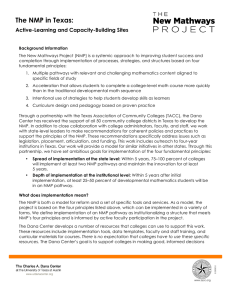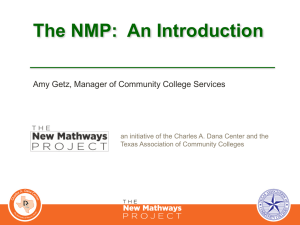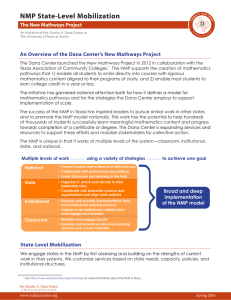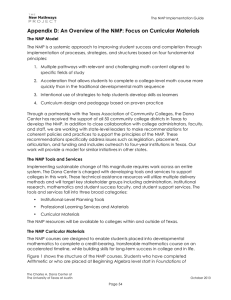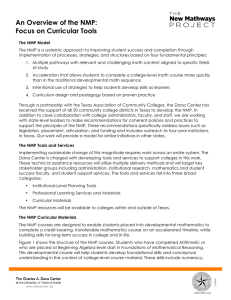Appendix A: The NMP in Texas: Active-Learning Sites and Capacity-
advertisement
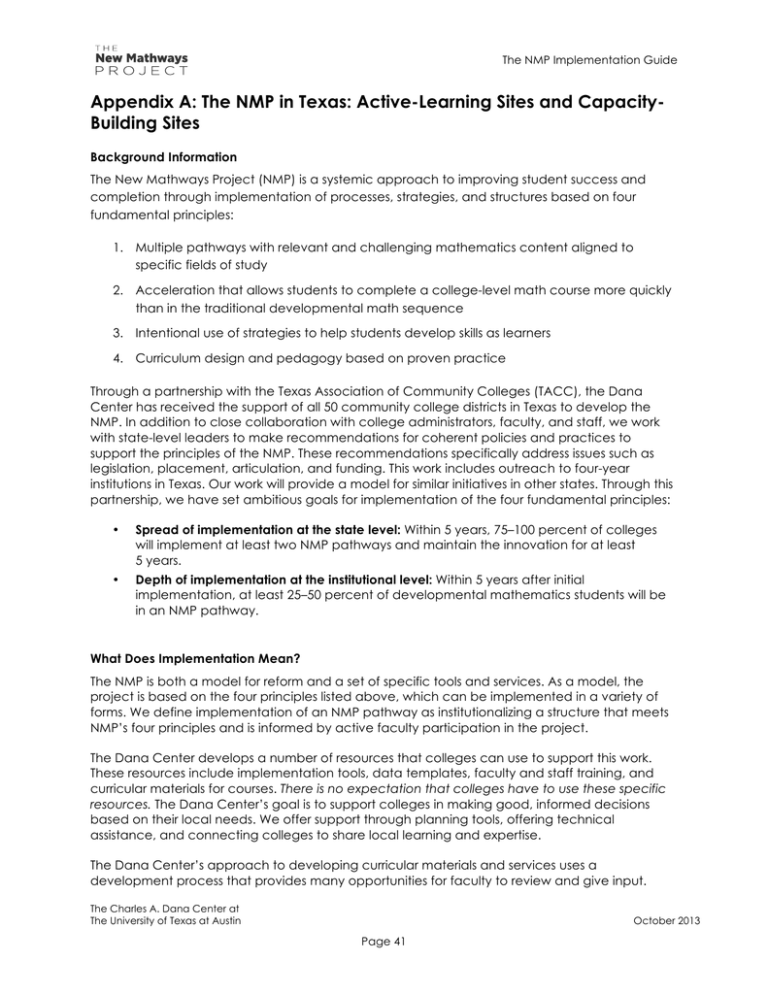
The NMP Implementation Guide Appendix A: The NMP in Texas: Active-Learning Sites and CapacityBuilding Sites Background Information The New Mathways Project (NMP) is a systemic approach to improving student success and completion through implementation of processes, strategies, and structures based on four fundamental principles: 1. Multiple pathways with relevant and challenging mathematics content aligned to specific fields of study 2. Acceleration that allows students to complete a college-level math course more quickly than in the traditional developmental math sequence 3. Intentional use of strategies to help students develop skills as learners 4. Curriculum design and pedagogy based on proven practice Through a partnership with the Texas Association of Community Colleges (TACC), the Dana Center has received the support of all 50 community college districts in Texas to develop the NMP. In addition to close collaboration with college administrators, faculty, and staff, we work with state-level leaders to make recommendations for coherent policies and practices to support the principles of the NMP. These recommendations specifically address issues such as legislation, placement, articulation, and funding. This work includes outreach to four-year institutions in Texas. Our work will provide a model for similar initiatives in other states. Through this partnership, we have set ambitious goals for implementation of the four fundamental principles: • Spread of implementation at the state level: Within 5 years, 75–100 percent of colleges will implement at least two NMP pathways and maintain the innovation for at least 5 years. • Depth of implementation at the institutional level: Within 5 years after initial implementation, at least 25–50 percent of developmental mathematics students will be in an NMP pathway. ! What Does Implementation Mean? The NMP is both a model for reform and a set of specific tools and services. As a model, the project is based on the four principles listed above, which can be implemented in a variety of forms. We define implementation of an NMP pathway as institutionalizing a structure that meets NMP’s four principles and is informed by active faculty participation in the project. The Dana Center develops a number of resources that colleges can use to support this work. These resources include implementation tools, data templates, faculty and staff training, and curricular materials for courses. There is no expectation that colleges have to use these specific resources. The Dana Center’s goal is to support colleges in making good, informed decisions based on their local needs. We offer support through planning tools, offering technical assistance, and connecting colleges to share local learning and expertise. The Dana Center’s approach to developing curricular materials and services uses a development process that provides many opportunities for faculty to review and give input. The Charles A. Dana Center at The University of Texas at Austin October 2013 Page 41 The NMP Implementation Guide Even colleges that do not intend to use the specific NMP curricular materials are encouraged to participate at some level for two reasons: 1. Input from a broader population improves the products. 2. The process of working with faculty from other institutions and engaging in this development informs their own reform efforts and strengthens the reform efforts statewide. Working at Scale in Texas Implementing the NMP at scale across Texas is critical—we must ensure that reform does not create a system of haves and have-nots. To enable participation throughout the community college system, we have worked with TACC to establish three development and implementation roles that provide all the colleges an opportunity to connect with one another and participate based on their own capacities and needs. The roles are described below. Codevelopment partners work closely with TACC and the Dana Center on the complex task of reengineering developmental mathematics and the gateway courses that are critical to student completion. Nine colleges have been selected as codevelopment partners based on an application process: Alamo Colleges–Northwest Vista College, Austin Community College, Brazosport College, El Paso Community College, Kilgore College, Lonestar College–Kingwood College, Midland College, South Texas College, and Temple College. Active-learning sites will implement the NMP in one to two years. Typically, these institutions have already started reform efforts and have built some level of faculty awareness and support. As an active-learning site, they are partnered with one of the codevelopment colleges in a mentoring relationship. This approach enables the active learners to observe the implementation process and receive support for their own planning. Some active-learning sites are already working on “home-grown” initiatives that are aligned with the NMP principles. The NMP serves as a vehicle to share information about these different reform efforts. Active-learning sites have committed to supporting time and resources for faculty to make site visits to codevelopment partners and to help disseminate information. The Dana Center will begin organizing mentoring relationships and site visits in Fall 2013. Capacity-building sites will implement the NMP in three to four years. Faculty at these institutions often have not had many opportunities to learn about the principles behind the NMP. The Dana Center will provide materials for an outreach campaign to inform the faculty and provide opportunities for them to engage in the statewide conversation with their peers at other institutions. Capacity-building sites have made a commitment to identify liaisons with whom the Dana Center can communicate and to hold at least one event a year to disseminate information to faculty and staff. This distinction between the NMP model and the NMP materials causes some confusion. The following examples demonstrate how colleges could take different approaches to implementation with different levels of involvement. Example 1: A college decides that its students will be best served by two pathways: quantitative reasoning and STEM preparation. As an active-learning site, administrators and faculty consult with a codevelopment partner on strategies for effective implementation. The faculty participate in selected NMP materials development and professional learning opportunities. This involvement helps them develop their own The Charles A. Dana Center at The University of Texas at Austin October 2013 Page 42 The NMP Implementation Guide courses in line with the four NMP principles. Faculty choose not to use the Dana Center’s curricular materials but decide to use some of the faculty training materials. Example 2: A college decides it will implement the Dana Center’s design for three pathways using the Dana Center curricular materials. Through mentorship with a codevelopment partner and collaboration with other active-learning sites, multiple colleges plan common faculty training and work together on implementation plans. The college faculty are deeply involved with the development of course materials and faculty training. Faculty leaders take roles as trainers and help support implementation at other institutions. Shaping the Policy Environment Working at scale requires attention to the policy and system-level factors that may inhibit institutional change. Individual colleges are not typically in the position to tackle potential policy obstacles to reform such as articulation, placement, and accreditation. Nor are state-level actors positioned to work on issues of content and courses. One of the greatest strengths of the TACC–Dana Center partnership is its ability to address issues that require state-level coordination based on input from people at all levels of the system. Together we are working with the Texas Higher Education Coordinating Board to identify potential obstacles to scale. We have initiated an outreach campaign to four-year institutions in the state with the support of the University of Texas System, which includes meeting with presidents, provosts, and mathematics faculty. More Information More details about the different aspects of the NMP work are available on the website at www.utdanacenter.org/mathways. This website will be periodically updated to provide specific information about the project in Texas, including a timeline for curriculum development, dates when materials will be available for public review, details of our plan for outreach to four-year institutions, and tools that colleges can use in their own work. To receive monthly updates on the NMP, including notices of when new information is posted on the website, contact us at mathways@austin.utexas.edu. The Charles A. Dana Center at The University of Texas at Austin October 2013 Page 43

